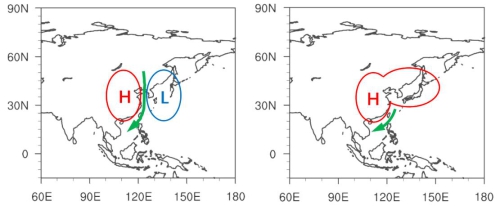A cold surge over the South China Sea (SCS) is one of the most hazardous weather phenomena during the boreal winter, which has great impact on tropical-extratropical interaction over East Asia.
Recently, Prof. LU Riyu and his team from the Institute of Atmospheric Physics, Chinese Academy of Sciences, found that two distinct patterns of sea level pressure (SLP) anomalies in East Asia have crucial roles in inducing cold surge over the SCS.
Specifically, the first type is characterized by a pair of SLP anomalies with positive and negative ones centered over China and Japan, respectively, whereas the second one is featured as widespread and persistent positive pressure anomalies over East Asia. Prior to both types, the Siberian high is significantly intensified. However, diagnosis of SLP tendency indicated that the intensification is related to different physical processes.
SLP anomalies associated with two types of cold surge over the SCS.

SLP anomalies associated with two types of cold surge over the SCS.
"Our investigations reveal the diversity of precursory signals responsible for the outbreak of cold surge, which is useful for the better understanding of cold surges over the SCS," concludes LU.
The findings have recently been published in Journal of Climate.
Reference
Pang, B., and R. Lu, 2019: Two Distinct Types of Extratropical Circulation Anomalies Associated with Cold Surges over the South China Sea. J. Climate, 32, 5069–5084. https://doi.org/10.1175/JCLI-D-19-0041.1
